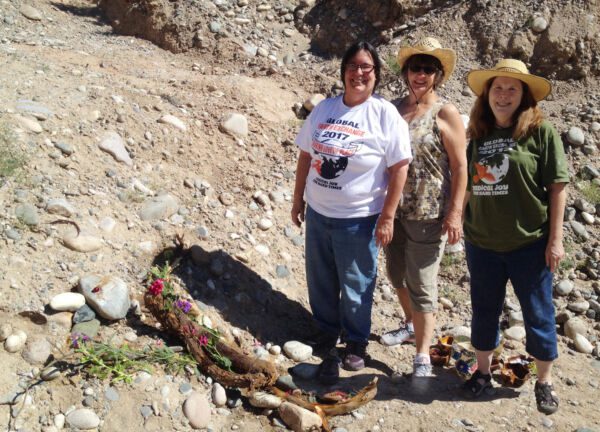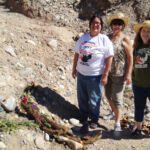Story Info
Story Info

Liz Gold
Espanola, New Mexico
2017
Type of Wounded Place
Story & Experience
For decades, gravel mines have decimated traditional Hispanic villages and sites sacred to native peoples in northern New Mexico, causing habitat destruction, air and water pollution, and unsightly scarring in the foothills of the Jemez Mountains, along the Rio Grande. Moreover, ancient petroglyphs have been ground up and lost forever. In our Earth Exchange we visited one of those sites, the El Guique gravel mine, and created an act of beauty.
We planned to do the Earth Exchange near but not on mine property. However, some local people wanted to meet us just outside the gates to the mine. We were waiting there at 9 am when the enormous, noisy gravel trucks started rolling in, every couple of minutes, and then rolling back out full of dirt. We were parked out of their way, but we felt we were experiencing the full woundedness of this place where the Earth is being scooped out by the truckful every few minutes.
As we were turning around our car to leave, one truck intentionally cut in extremely close, so we had to back up fast to avoid being hit. It was frightening. Perhaps the driver felt we were threatening his job, though we were just sitting in the car. We thought of the people at Standing Rock who faced aggression by truck drivers, and we thought of other people fighting for the Earth who have faced far worse. We tried to pray for the driver.
We drove down to a spot opposite the mine in the shade of two enormous cottonwood trees. Below us on one side stretched houses, farms, and green fields as far as we could see, in the ancient floodplain of the Rio Grande. They were fed by a lovely, wide, centuries-old acequia (irrigation canal) dug by hand by Hispanic villagers. It was difficult to square this beauty with the ugliness of the 300-acre mine we could not see, but knew was just below the small hills on the other side of the road.
As we sat, we noticed birds in the trees above us and wildflowers and medicinal plants all around us. We talked about the beautiful place and our feelings about what had happened to it. Then we crossed the road and made a RadJoy bird out of stones and twisted wood we found there, and flowers we’d brought. We scattered cornmeal, sacred dirt from the Santuario de Chimayó, and water from a sacred spring in Chimayó. We told the place we still loved it, no matter what other humans were doing to it. We thanked it for giving us jobs, roads, cement for building, and probably the gravel in our own driveway.
We also took water and poured it into the acequia, which had been damaged by the mine in the past, and prayed for healing for all the people and animals of El Guique. We then drove a little further and saw magnificent petroglyphs. We thanked the ancient ones with cornmeal. We left with sadness but also joy in our hearts and gratitude for this way of connecting with each other and with this place.
For decades, gravel mines have decimated traditional Hispanic villages and sites sacred to native peoples in northern New Mexico, causing habitat destruction, air and water pollution, and unsightly scarring in the foothills of the Jemez Mountains, along the Rio Grande. Moreover, ancient petroglyphs have been ground up and lost forever. In our Earth Exchange we visited one of those sites, the El Guique gravel mine, and created an act of beauty.
We planned to do the Earth Exchange near but not on mine property. However, some local people wanted to meet us just outside the gates to the mine. We were waiting there at 9 am when the enormous, noisy gravel trucks started rolling in, every couple of minutes, and then rolling back out full of dirt. We were parked out of their way, but we felt we were experiencing the full woundedness of this place where the Earth is being scooped out by the truckful every few minutes.
As we were turning around our car to leave, one truck intentionally cut in extremely close, so we had to back up fast to avoid being hit. It was frightening. Perhaps the driver felt we were threatening his job, though we were just sitting in the car. We thought of the people at Standing Rock who faced aggression by truck drivers, and we thought of other people fighting for the Earth who have faced far worse. We tried to pray for the driver.
We drove down to a spot opposite the mine in the shade of two enormous cottonwood trees. Below us on one side stretched houses, farms, and green fields as far as we could see, in the ancient floodplain of the Rio Grande. They were fed by a lovely, wide, centuries-old acequia (irrigation canal) dug by hand by Hispanic villagers. It was difficult to square this beauty with the ugliness of the 300-acre mine we could not see, but knew was just below the small hills on the other side of the road.
As we sat, we noticed birds in the trees above us and wildflowers and medicinal plants all around us. We talked about the beautiful place and our feelings about what had happened to it. Then we crossed the road and made a RadJoy bird out of stones and twisted wood we found there, and flowers we’d brought. We scattered cornmeal, sacred dirt from the Santuario de Chimayó, and water from a sacred spring in Chimayó. We told the place we still loved it, no matter what other humans were doing to it. We thanked it for giving us jobs, roads, cement for building, and probably the gravel in our own driveway.
We also took water and poured it into the acequia, which had been damaged by the mine in the past, and prayed for healing for all the people and animals of El Guique. We then drove a little further and saw magnificent petroglyphs. We thanked the ancient ones with cornmeal. We left with sadness but also joy in our hearts and gratitude for this way of connecting with each other and with this place.
Espanola, New Mexico
RECENT STORIES
For the Gulf Coast
Our beaches are being bombarded almost daily since the end of the first week of the sinking of the Deep Water Horizon with gatherings of people or all stripes: protests, prayer groups, volunteers, rallies for [...]
Remembrance Day for Lost Species in Helsinki 2023
On November 30th, there was first a session organized by the Finnish social and health sector project about eco-anxiety and eco-emotions (www.ymparistoahdistus.fi). This “morning coffee roundtable”, a hybrid event, focused this time on ecological grief [...]
Ashdown Forest
Ashdown Forest is an area of natural beauty in West Sussex, England. It is also one of the very few remaining areas of extensive lowland heath left in Europe. This rare and threatened landscape is [...]



